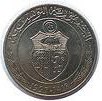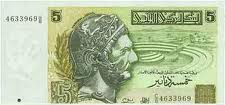|


The dinar (Arabic: دينار, ISO 4217 currency code: TND) is the currency of Tunisia. It is subdivided into 1000 milim or millimes (مليم). The abbreviation DT is often used in Tunisia, although writing "dinar" after the amount is also acceptable (TND is less colloquial, and tends to be used more in financial circles); the abbreviation TD is also mentioned in a few places, but is less frequently used, given the common use of the French language in Tunisia, and the French derivation of DT (i.e., Dinar tunisien).
History
The dinar was introduced in 1960, having been established as a unit of account in 1958. It replaced the franc at a rate of 1000 francs = 1 dinar. The dinar did not follow the devaluation of the French franc in 1958, resulting in the initially exchange rate of 1000 French francs = 1 dinar being abandoned. Instead a peg to the United States dollar of 0.42 dinar = 1 dollar was established which was maintained until 1964, when the dinar devalued to 0.525 dinar = 1 dollar. This second rate was held until the dollar was devalued in 1971.
Coins
In 1960, aluminium 1, 2 and 5 milim and brass 10, 20, 50 and 100 milim coins were introduced. The 1 and 2 milim were last issued in 1980 and 1983 respectively, and are no longer legal tender. In 1968, nickel ½ dinar coins were introduced, replaced by smaller, cupro-nickel pieces in 1976, when cupro-nickel 1 dinar coins were also introduced. Bimetallic 5 dinar coins were introduced in 2002.
Coins in circulation are
* 5 milim
* 10 milim
* 20 milim
* 50 milim
* 100 milim
* ½ dinar
* 1 dinar
* 5 dinar
Banknotes
In 1960, banknotes were introduced by the Central Bank of Tunisia in denominations of ½, 1 and 5 dinar. These were followed by 10 dinar notes in 1969. The last ½ dinar notes were dated 1973 whilst the last 1 dinar notes were dated 1980. 20 dinar notes were introduced in 1980, with the last 5 dinar notes dated 1993. 30 dinar notes were issued in 1997. 50 dinar notes were issued on the 25 July 2009 . In 2006 an updated version of the frequently used 10 dinar note, with holographic foil, was issued.
Popular nomenclature
Tunisians sometimes do not use the main division, dinar, when mentioning prices of goods...etc. Accordingly, 50 dinar would be, naturally, referred to as khamsin alf (fifty thousand). This convention is used even for higher prices, for example 70,000 dinars would be called sab'in maliun (seventy million). "Francs" is also still heard from time to time, 1000 of them colloquially representing a single dinar.
Currency restrictions
It is a criminal offence in Tunisia to import or export dinar. No more than 3,000 Tunisian dinar can be converted into foreign currency before departure from the North-African country., Therefore, prices at duty-free shops are in convertible currencies like euros, US dollars and British pounds. There are many converting ATMs in the country for tourists. It is necessary for anyone leaving Tunisia to declare any cash in their possession exceeding the equivalent of UK£500 beforehand.
The text on this page has been made available under the Creative Commons Attribution-ShareAlike License and Creative Commons Licenses
|
